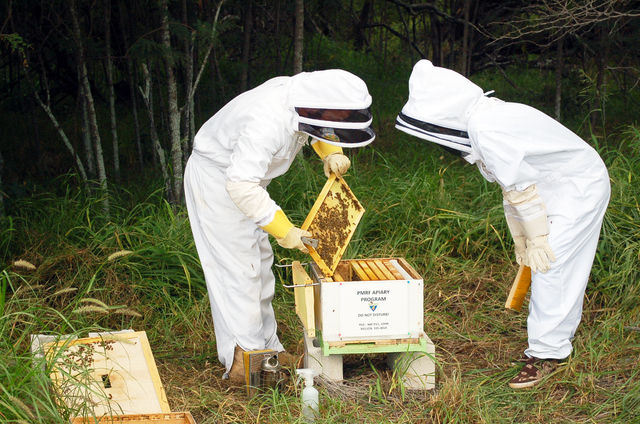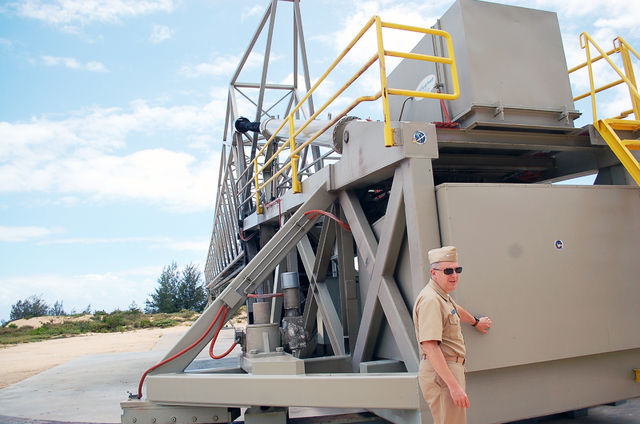BARKING SANDS — The heavy hum of several hundred honeybees got a little louder when John Nelson popped the top of one of six bee boxes at the Pacific Missile Range Facility.
Nelson, installation environmental program director at PMRF and a former entomologist with the U.S. Army Medical Command, started establishing the bees’ outpost at PMRF last fall.
“I wanted to have them here so we can do some research on the varroa mite problem,” Nelson said. “We’ve been doing some tests on their wax, as well.”
Varroa mites are parasites that attack both honeybees and their brood; the tiny insects have been blamed for the collapse of entire colonies. The mites are not on Kauai, but Nelson said they are a “huge concern.”
Capt. Bruce Hay, PMRF commander, was quick to grant Nelson’s request for bees on base and said he is very interested to see how Nelson’s project will unfold.
Boxes of bees might seem out of place on training and testing range — the place famous for testing ballistic missile defense programs — but Hay said they’re welcome.
“Defending freedom and defending our food source aren’t mutually exclusive,” Hay said.
Bees aren’t the only critters that make an appearance at PMRF. Pheasants, turtles and Hawaiian monk seals often grace the base with their presence. Hay said he’s even seen a few black tail deer in his three years at the facility.
“We have a lot of life out here, and we’re shooting things into space and have all of this cutting-edge technology,” Hay said.
The Super Strypi launch vehicle is one of those pieces of cutting-edge technology. In November, the U.S. military launched a 68,000-pound rocket from the vehicle, which is located on base.
“It lasted about a minute before it failed,” Hay said.
But that Nov. 3 launch marked the first-ever satellite launch attempt from Hawaii, from the island’s only rocket launcher. The military is evaluating the failed launch.
Hay said NASA has been at PMRF for launches in the past as well.
“We’re not a space port, but we put things in space,” Hay said.
In addition to space, PMRF has hydrophones about 15,000 feet underwater. The base encompasses about 1,000 square miles of underwater space, about 42,000 square miles of airspace, and stretches about 2.1 million square miles of extended operating area in the Pacific.
From the facility, the U.S. military can support land, air, space and underwater operations simultaneously.
“Most of what we do happens over the water,” Hay said.
PMRF also has support facilities at Port Allen, Makaha Ridge, Kokee State Park and on the island of Niihau.
The facility provides a place for training exercises from the basic level all the way through advanced, and is used by various branches of the military for a variety of exercises.
“Not all of the things we do here are these huge events,” Hay said. “Some of it is just flying around and learning formation, that kind of training.”
Other countries, including Canada and Japan, also use PMRF for training exercises. The base also plays a small part in the Rim of the Pacific exercises (RIMPAC), which happen every two years and bring nearly 50 nations together for training exercises in the Pacific Ocean.
The activities of RIMPAC, once again happening in July, will mostly be hosted on Oahu. Hay said once in a while someone may need to refuel on base, but usually participants eat and stay in Honolulu.
Everything that happens at PMRF is defensive, Hay explained. They don’t do offensive combat events. They also don’t stock missiles for their training exercises — the facility ships in all of the supplies and does the assembly on-site for their tests as they happen.
“It’s kind of that retail mentality of ‘product on the shelf is money that’s tied up,’” Hay said.
When they do initiate training exercises, those involved work 12- to 14-hour days leading up to dry runs and dress rehearsals before they launch the actual test. They also do a few tests where they induce failure so all scenarios are covered.
The base itself stretches along about 7.5 miles of beach and employs between 900 and 1,000 people, mostly civilians who live on Kauai and work at the base.
“We have generations of people that work here and many of the people on Kauai’s Westside work at PMRF,” Hay said. “In Indiana, it’s the automobile industry where everybody works; on the Westside, it’s here.”
The community is welcome to visit the base through the Morale, Welfare and Recreation guest card. The annual cost is $25 – that goes straight to a background check. It gives civilians access to Majors Bay beach park, Shenanigans Bar & Restaurant, and to the outdoor movies.
He said one of the most rewarding parts of his job is interacting with the community members and island residents he sees daily — he calls them his “ohana.”
“We’re part of the community and we like to be engaged,” Hay said.






